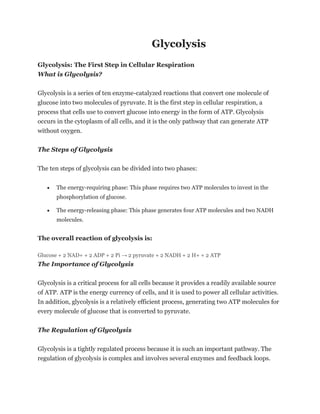
Glycolysis.pdf
- 1. Glycolysis Glycolysis: The First Step in Cellular Respiration What is Glycolysis? Glycolysis is a series of ten enzyme-catalyzed reactions that convert one molecule of glucose into two molecules of pyruvate. It is the first step in cellular respiration, a process that cells use to convert glucose into energy in the form of ATP. Glycolysis occurs in the cytoplasm of all cells, and it is the only pathway that can generate ATP without oxygen. The Steps of Glycolysis The ten steps of glycolysis can be divided into two phases: • The energy-requiring phase: This phase requires two ATP molecules to invest in the phosphorylation of glucose. • The energy-releasing phase: This phase generates four ATP molecules and two NADH molecules. The overall reaction of glycolysis is: Glucose + 2 NAD+ + 2 ADP + 2 Pi → 2 pyruvate + 2 NADH + 2 H+ + 2 ATP The Importance of Glycolysis Glycolysis is a critical process for all cells because it provides a readily available source of ATP. ATP is the energy currency of cells, and it is used to power all cellular activities. In addition, glycolysis is a relatively efficient process, generating two ATP molecules for every molecule of glucose that is converted to pyruvate. The Regulation of Glycolysis Glycolysis is a tightly regulated process because it is such an important pathway. The regulation of glycolysis is complex and involves several enzymes and feedback loops.
- 2. Anaerobic Glycolysis Glycolysis can occur in the absence of oxygen, a process called anaerobic glycolysis. Anaerobic glycolysis is less efficient than aerobic glycolysis, generating only two ATP molecules for every molecule of glucose that is converted to pyruvate. However, anaerobic glycolysis is an important process for cells that need to generate ATP quickly, such as muscle cells during exercise. Lactic Acid Fermentation When anaerobic glycolysis occurs faster than the rate at which pyruvate can be converted to lactate, pyruvate can be converted to lactate. Lactate accumulation in the muscles is what causes muscle fatigue. Glycolysis is a fundamental process in cellular metabolism. It is the first step in cellular respiration and is the only pathway that can generate ATP without oxygen. Glycolysis is important for all cells because it provides a readily available source of ATP. Unlocking the Secrets of Glycolysis: The Pathway to Cellular Energy In the bustling metropolis of our cells, where countless chemical reactions occur, a crucial process takes center stage – glycolysis. This intricate metabolic pathway, much like a well-orchestrated symphony, transforms a simple sugar molecule, glucose, into a valuable energy source, pyruvate. Let's delve into the fascinating world of glycolysis, unraveling its steps, significance, and regulation. The Glycolytic Journey: From Glucose to Pyruvate Glycolysis, a series of ten enzyme-catalyzed reactions, unfolds in the cytoplasm of cells, the bustling hub of cellular activity. This intricate pathway can be broadly divided into two phases: Phase 1: Energy Investment In this initial phase, two ATP molecules are invested to phosphorylate glucose, converting it into a more reactive form. This investment is akin to priming the pump, setting the stage for energy production. Phase 2: Energy Release This phase reaps the rewards of the initial investment. Through a series of enzymatic steps, glucose is cleaved into two pyruvate molecules, generating four ATP molecules in
- 3. the process. Additionally, two NADH molecules, electron-carrying molecules, are produced. The Overall Glycolysis Equation The overall equation of glycolysis encapsulates this energy transformation: Glucose + 2 NAD+ + 2 ADP + 2 Pi → 2 pyruvate + 2 NADH + 2 H+ + 2 ATP The Significance of Glycolysis: A Cellular Powerhouse Glycolysis stands as a cornerstone of cellular energy metabolism for several reasons: 1. Readily Available Energy Source: Glycolysis provides a constant and accessible source of ATP, the energy currency of cells, powering essential cellular processes. 2. Efficiency: Glycolysis is a relatively efficient process, generating two ATP molecules per glucose molecule, making it a valuable energy source. 3. Oxygen Independence: Unlike other energy-generating pathways, glycolysis can function in the absence of oxygen, making it crucial for cells that need rapid energy bursts, such as muscle cells during intense exercise. Regulation of Glycolysis: Fine-tuning Energy Production Given its critical role, glycolysis is tightly regulated to ensure energy production matches cellular demands. Several enzymes and feedback loops act as control points, adjusting the pathway's activity in response to cellular needs. Anaerobic Glycolysis: Energy without Oxygen When oxygen levels plummet, glycolysis can still operate, a process termed anaerobic glycolysis. However, anaerobic glycolysis is less efficient, producing only two ATP molecules per glucose. The resulting pyruvate is converted into lactate, a molecule responsible for muscle fatigue. Lactic Acid Fermentation: A Survival Mechanism When anaerobic glycolysis exceeds pyruvate's removal rate, lactate accumulation occurs. This accumulation triggers lactic acid fermentation, a process that converts pyruvate into lactate, preventing cellular acidification and enabling continued energy production. Glycolysis – A Cornerstone of Cellular Energy Metabolism Glycolysis, the first step in cellular respiration, stands as a fundamental process in cellular metabolism. It provides a readily available source of ATP, powering essential cellular functions, and can operate independently of oxygen, making it crucial for energy demands during intense exercise. The intricate regulation and versatility of glycolysis underscore its significance in maintaining cellular energy homeostasis.